IL-33 Enhances the Total Production of IgG, IgG1, and IgG3 in Angiostrongylus cantonensis-Infected Mice
Abstract
1. Introduction
2. Materials and Methods
2.1. Animals
2.2. Treatments and Larvae Recovery
2.3. Immunoglobulin Assays
2.4. Statistical Analysis
3. Results
3.1. The Levels of Total Immunoglobulin G
3.2. The Levels of IgG Subclasses
3.3. The Levels of IgE
3.4. The Proportions of IgG Subclasses
3.5. Larva Recovery
4. Discussion
Author Contributions
Funding
Institutional Review Board Statement
Informed Consent Statement
Data Availability Statement
Conflicts of Interest
References
- Tsai, H.C.; Lee, S.S.; Huang, C.; Yen, C.M.; Chen, E.R.; Liu, Y.C. Outbreak of eosinophilic meningitis associated with drinking raw vegetable juice in southern Taiwan. Am. J. Trop. Med. Hyg. 2004, 71, 222–226. [Google Scholar] [CrossRef] [PubMed]
- Furugen, M.; Yamashiro, S.; Tamayose, M.; Naha, Y.; Miyagi, K.; Nakasone, C.; Uchihara, T.; Haranaga, S.; Azuma, M.; Yara, S.; et al. Elsberg syndrome with eosinophilic meningoencephalitis caused by Angiostrongylus cantonensis. Intern. Med. 2006, 45, 1333–1336. [Google Scholar] [CrossRef] [PubMed]
- Wang, J.; Qi, H.; Diao, Z.; Zheng, X.; Li, X.; Ma, S.; Ji, A.; Yin, C. An Outbreak of Angiostrongyliasis cantonensis in Beijing. J. Parasitol. 2010, 96, 377–381. [Google Scholar] [CrossRef] [PubMed]
- Yen, C.M.; Chen, E.R. Detection of antibodies to Angiostrongylus cantonensis in serum and cerebrospinal fluid of patients with eosinophilic meningitis. Int. J. Parasitol. 1991, 21, 17–21. [Google Scholar] [PubMed]
- Sugaya, H.; Aoki, M.; Abe, T.; Ishida, K.; Yoshimura, K. Cytokine responses in mice infected with Angiostrongylus cantonensis. Parasitol. Res. 1997, 83, 10–15. [Google Scholar] [CrossRef] [PubMed]
- Intapan, P.M.; Kittimongkolma, S.; Niwattayakul, K.; Sawanyawisuth, K.; Maleewong, W. Cerebrospinal fluid cytokine responses in human eosinophilic meningitis associated with angiostrongyliasis. J. Neurol. Sci. 2008, 267, 17–21. [Google Scholar] [CrossRef] [PubMed]
- Du, W.Y.; Chen, C.W.; Lin, F.K.; Chuang, C.C. IL-33 mediates the expressions of IL-5 and IL-13 in Angiostrongylus cantonensis-infected mice. Exp. Parasitol. 2013, 135, 587–594. [Google Scholar] [CrossRef] [PubMed]
- Hjelholt, A.; Christiansen, G.; Sorensen, U.S.; Birkelund, S. IgG subclass profiles in normal human sera of antibodies specific to five kinds of microbial antigens. Pathog. Dis. 2013, 67, 206–213. [Google Scholar] [CrossRef]
- Vidarsson, G.; Dekkers, G.; Rispens, T. IgG subclasses and allotypes: From structure to effector functions. Front. Immunol. 2014, 20, 520. [Google Scholar] [CrossRef]
- Damelang, T.; de Taeye, S.W.; Rentenaar, R.; Roya-Kouchaki, K.; de Boer, E.; Derksen, N.I.; Kessel, K.V.; Lissenberg-Thunnissen, S.; Rooijakkers, S.H.M.; Jongerius, I.; et al. The influence of human IgG subclass and allotype on complement activation. J. Immunol. 2023, 211, 1725–1735. [Google Scholar] [CrossRef]
- Intapan, P.M.; Maleewong, W.; Polsan, Y.; Sawanyawisuth, K.; Chotomongkoi, V. Specific IgG antibody subclasses to Angiostrongylus cantonensis in patients with angiostrongyliasis. Asian Pac. J. Allergy Immunol. 2002, 20, 235–240. [Google Scholar] [PubMed]
- Cayrol, C.; Girard, J.P. IL-33: An alarmin cytokine with crucial roles in innate immunity, inflammation and allergy Curr. Opin. Immunol. 2014, 31, 31–37. [Google Scholar] [CrossRef] [PubMed]
- Molofsky, A.B.; Savage, A.K.; Locksley, R.M. Interleukin-33 in tissue homeostasis, injury, and inflammation. Immunity 2015, 42, 1005–1019. [Google Scholar] [CrossRef] [PubMed]
- Saikumar Jayalatha, A.K.; Hesse, L.; Ketelaar, M.E.; Koppelman, G.H.; Nawijn, M.C. The central role of IL-33/IL-1 RL1 pathway in asthma: From pathogenesis to intervention. Pharmacol. Ther. 2021, 225, 107847. [Google Scholar] [CrossRef] [PubMed]
- Schmitz, J.; Owyang, A.; Oldham, E.; Song, Y.; Murphy, E.; McClanahan, T.K.; Zurawski, G.; Moshrefi, M.; Qin, J.; Li, X.; et al. IL-33, an interleukin-1-like cytokine that signals via the IL-1 receptor-related protein ST2 and induces T helper type 2-associated cytokines. Immunity 2005, 23, 479–490. [Google Scholar] [CrossRef] [PubMed]
- Lingel, A.; Weiss, T.M.; Niebuhr, M.; Pan, B.; Appleton, B.A.; Wiesmann, C.; Bazan, J.F.; Fairbrother, W. Structure of IL-33 and its interaction with the ST2 and IL-1RAcP receptors--insight into heterotrimeric IL-1 signaling complexes. Structure 2009, 17, 1398–1410. [Google Scholar] [CrossRef] [PubMed]
- Hayakawa, H.; Hayakawa, M.; Kume, A.; Tominaga, S. Soluble ST2 blocks interleukin-33 signaling in allergic airway inflammation. J. Biol. Chem. 2007, 282, 26369–26380. [Google Scholar] [CrossRef] [PubMed]
- Peng, H.; Sun, R.; Zhang, Q.; Zhao, J.; Wei, J.; Zeng, X.; Zheng, H.; Wu, Z. Interleukin 33 mediates type 2 immunity and inflammation in the central nervous system of mice infected with Angiostrongylus cantonensis. J. Infect. Dis. 2013, 207, 860–869. [Google Scholar] [CrossRef] [PubMed]
- Chuang, C.C.; Chen, C.W.; Huang, Y.T.; Du, W.Y. Anti-ST2 monoclonal antibody inhibits eosinophil infiltration in Angiostrongylus cantonensis-infected mice. J. Microbiol. Immunol. Infect. 2016, 49, 91–96. [Google Scholar] [CrossRef][Green Version]
- Jefferis, R.; Lund, J.; Pound, J.D. IgG-Fc-mediated effector functions: Molecular definition of interaction sites for effector ligands and the role of glycosylation. Immunol. Rev. 1998, 163, 59–76. [Google Scholar] [CrossRef]
- Préfontaine, D.; Lajoie-Kadoch, S.; Foley, S.; Audusseau, S.; Olivenstein, R. Immunity. expression by airway smooth muscle cells. J. Immunol. 2009, 183, 5094–5103. [Google Scholar] [CrossRef] [PubMed]
- Kamekura, R.; Kojima, T.; Takano, K.; Go, M.; Sawada, N.; Himi, T. The role of IL-33 and its receptor ST2 in human nasal epithelium with allergic rhinitis. Clin. Exp. Allergy 2012, 42, 218–228. [Google Scholar] [CrossRef] [PubMed]
- Okano, M.; Hirahara, K.; Kiuchi, M.; Onoue, M.; Iwamura, C.; Kokubo, K.; Hishiya, T.; Morimoto, Y.; Ikehara, Y.; Murakami, A.; et al. Interleukin-33-activated neuropeptide CGRP-producing memory Th2 cells cooperate with somatosensory neurons to induce conjunctival itch. Immunity 2022, 55, 2352–2368.e7. [Google Scholar] [CrossRef]
- Hsu, C.L.; Neilsen, C.V.; Bryce, P.J. IL-33 is produced by mast cells and regulates IgE-dependent inflammation. PLoS ONE 2010, 5, e11944. [Google Scholar] [CrossRef]
- Coffman, R.L.; Savelkoul, H.F.; Lebman, D.A. Cytokine regulation of immunoglobulin isotype switching and expression. Semin. Immunol. 1989, 1, 55–63. [Google Scholar]
- Vercelli, D.; Geha, R.S. Regulation of isotype switching. Curr. Opin. Immunol. 1992, 4, 794–797. [Google Scholar] [CrossRef]
- Avery, D.T.; Bryant, V.L.; Ma, C.S.; de Waal Malefyt, R.; Tangye, S.G. IL-21-induced isotype switching to IgG and IgA by human naive B cells is differentially regulated by IL-4. J. Immunol. 2008, 181, 1767–1779. [Google Scholar] [CrossRef]
- Chakma, C.R.; Good-Jacobson, K.L. Requirements of IL-4 during the Generation of B Cell Memory. J. Immunol. 2023, 210, 1853–1860. [Google Scholar] [CrossRef] [PubMed]
- Kawano, Y.; Noma, T.; Yata, J. Regulation of human IgG subclass production by cytokines. IFN-gamma and IL-6 act antagonistically in the induction of human IgG1 but additively in the induction of IgG2. J. Immunol. 1994, 153, 4948–4958. [Google Scholar] [CrossRef]
- Snapper, C.M.; Peschel, C.; Paul, W.E. IFN-gamma stimulates IgG2a secretion by murine B cells stimulated with bacterial lipopolysaccharide. J. Immunol. 1988, 140, 2121–2127. [Google Scholar] [CrossRef]
- Humphreys, N.E.; Xu, D.; Hepworth, M.R.; Liew, F.Y.; Grencis, R.K. IL-33, a potent inducer of adaptive immunity to intestinal nematodes. J. Immunol. 2008, 180, 2443–2449. [Google Scholar] [CrossRef] [PubMed]
- Hung, L.Y.; Lewkowich, I.P.; Dawson, L.A.; Downey, J.; Yang, Y.; Smith, D.E.; Herbert, D.R. IL-33 drives biphasic IL-13 production for noncanonical Type 2 immunity against hookworms. Proc. Natl. Acad. Sci. USA 2013, 110, 282–287. [Google Scholar] [CrossRef] [PubMed]
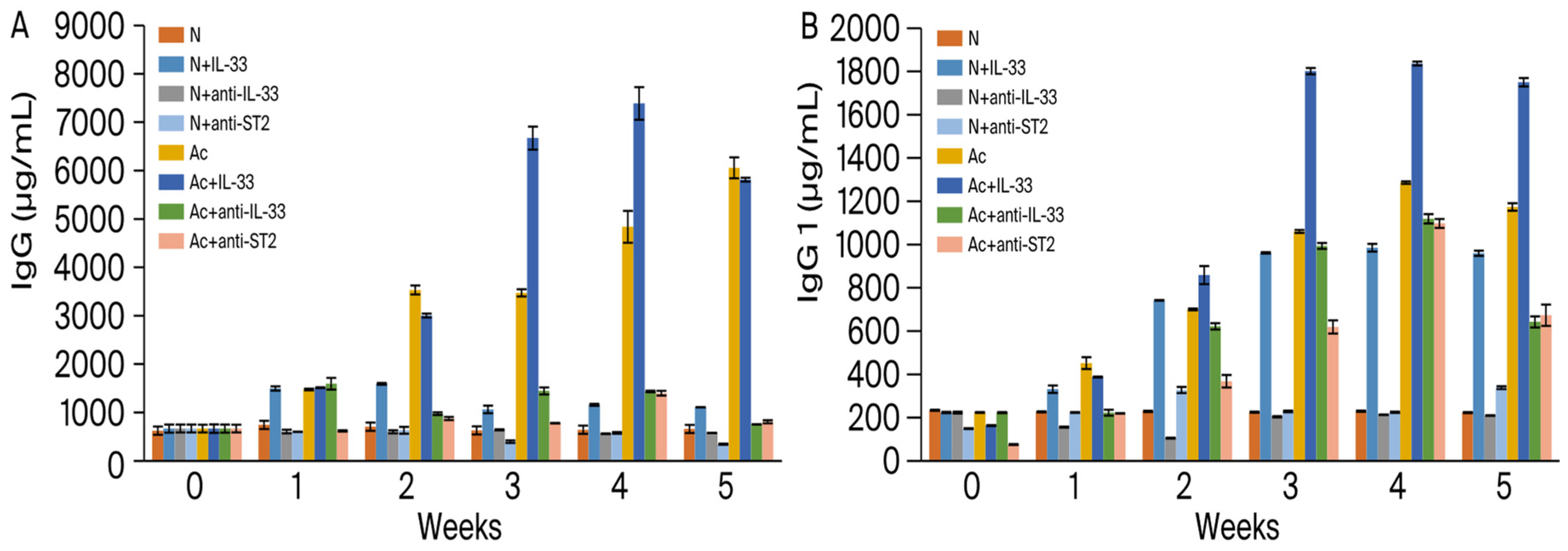
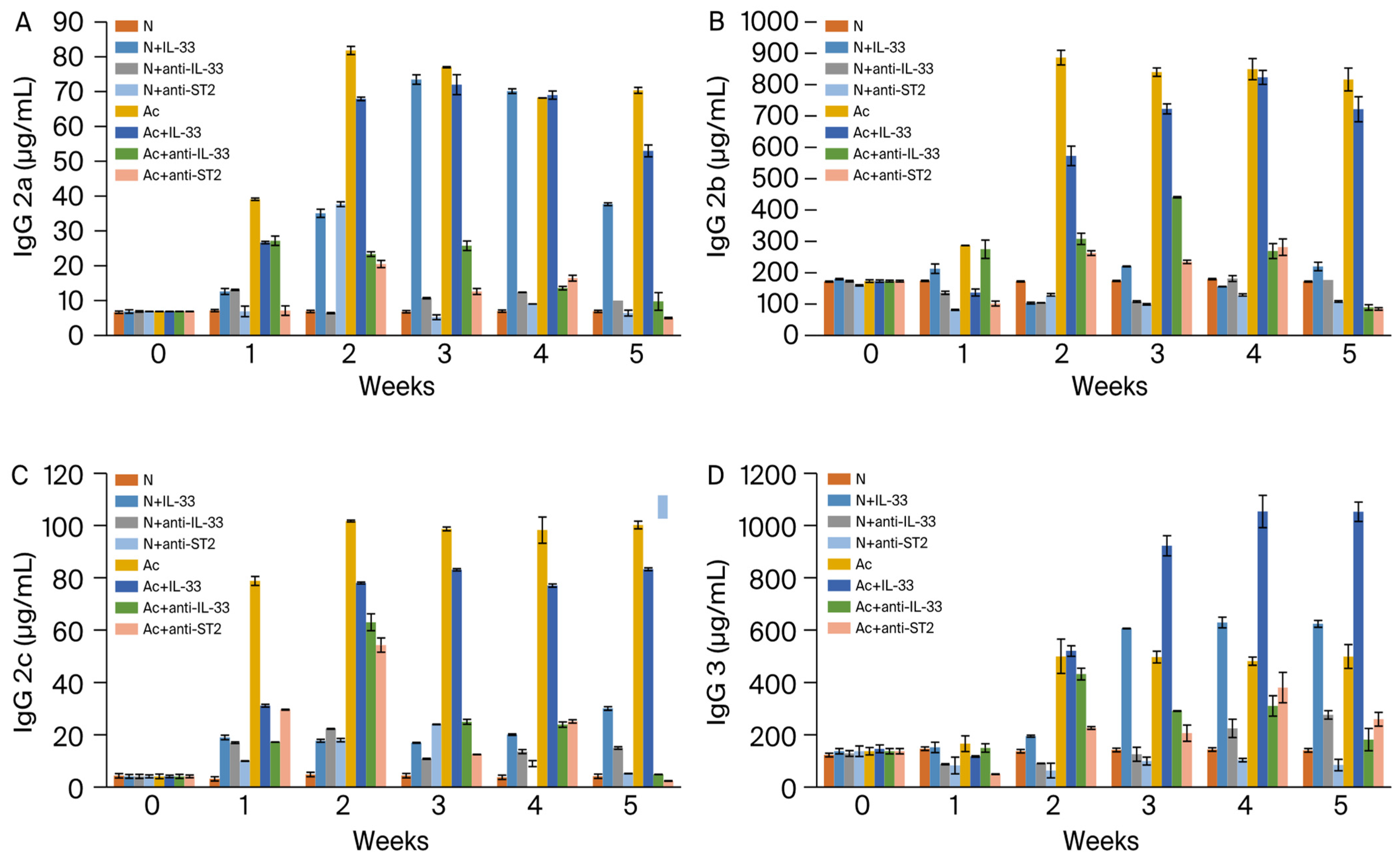
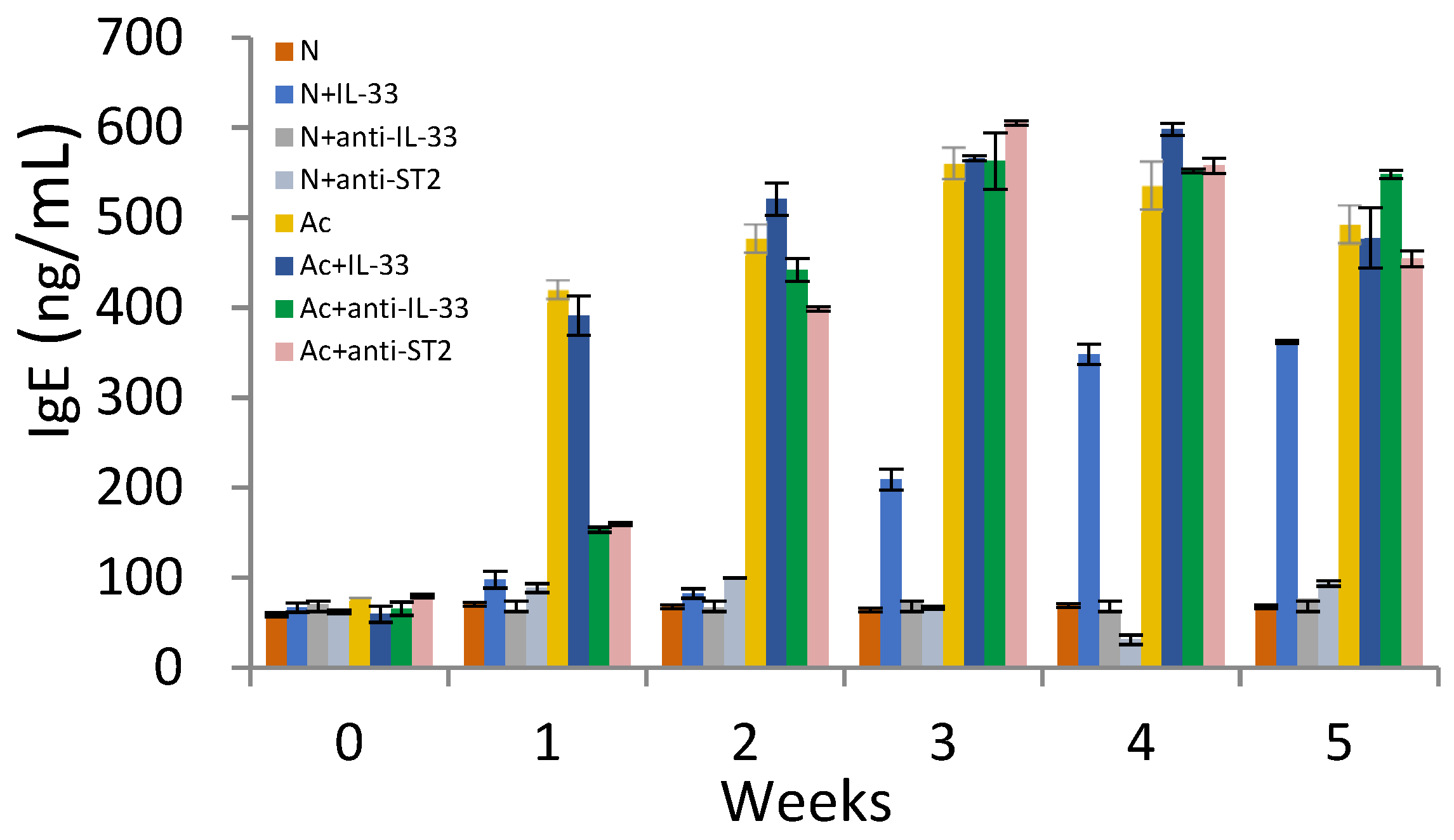
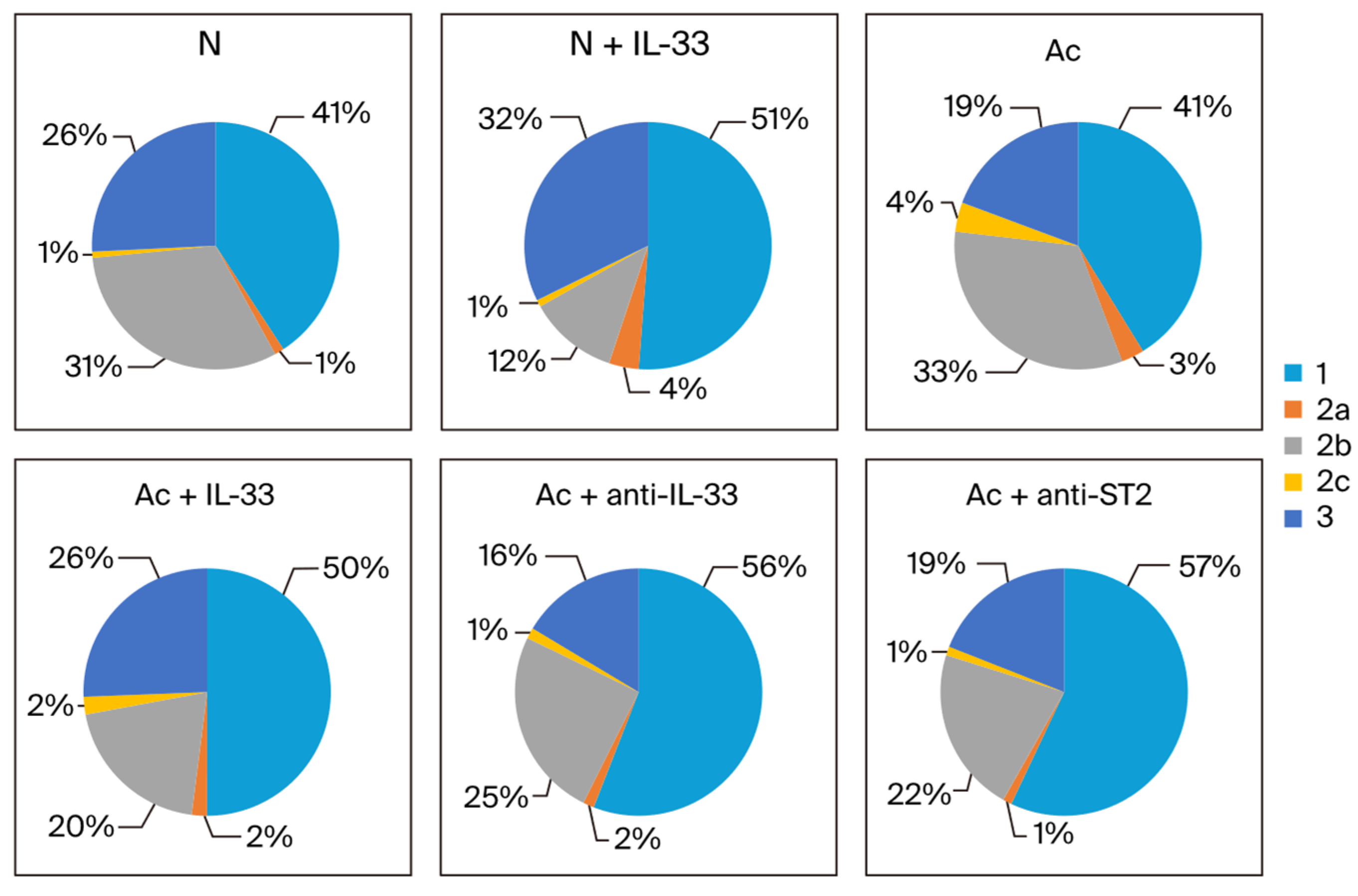
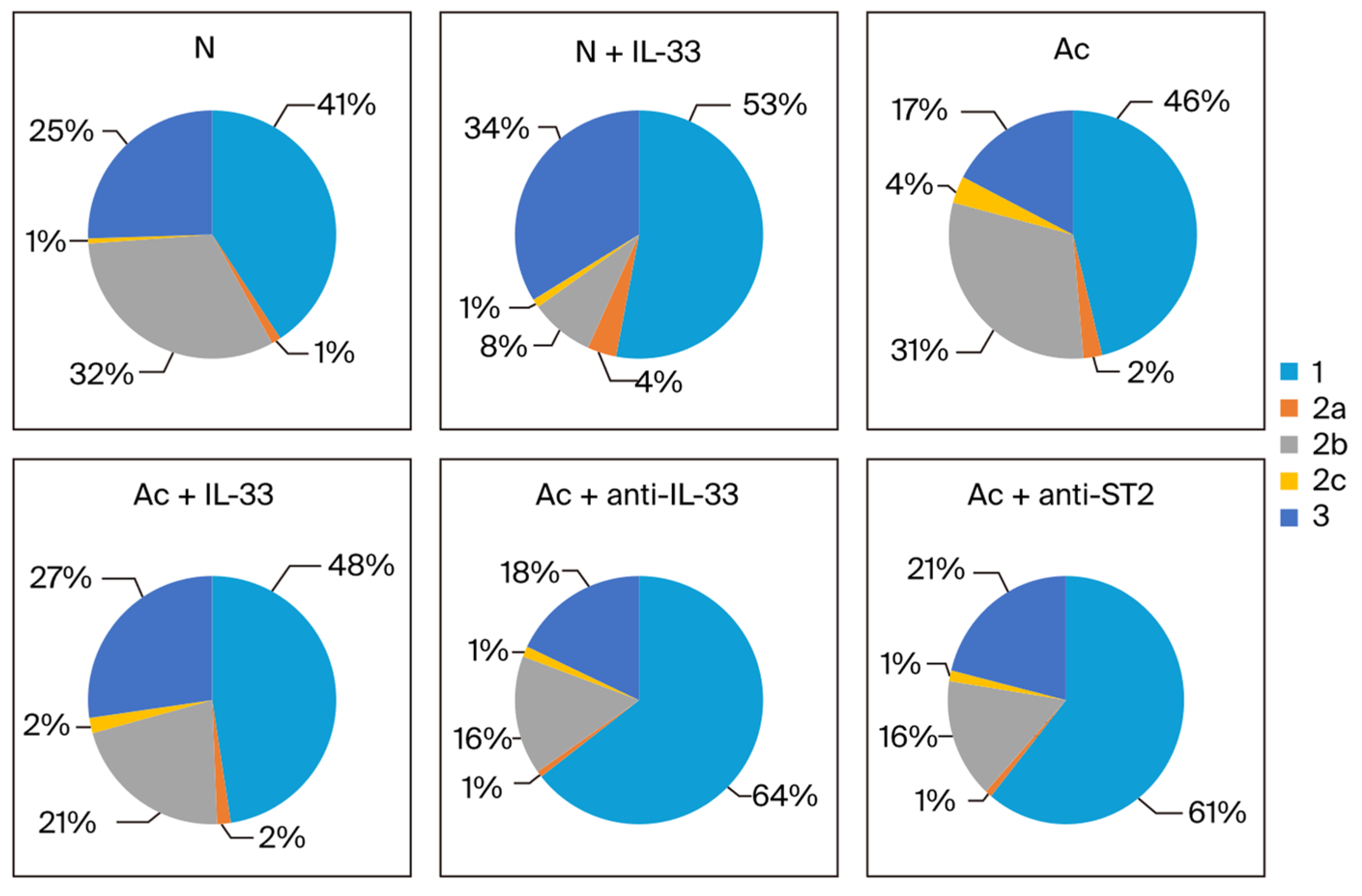
Disclaimer/Publisher’s Note: The statements, opinions and data contained in all publications are solely those of the individual author(s) and contributor(s) and not of MDPI and/or the editor(s). MDPI and/or the editor(s) disclaim responsibility for any injury to people or property resulting from any ideas, methods, instructions or products referred to in the content. |
© 2024 by the authors. Licensee MDPI, Basel, Switzerland. This article is an open access article distributed under the terms and conditions of the Creative Commons Attribution (CC BY) license (https://creativecommons.org/licenses/by/4.0/).
Share and Cite
Su, P.-A.; Ma, M.-C.; Wu, W.-B.; Wang, J.-J.; Du, W.-Y. IL-33 Enhances the Total Production of IgG, IgG1, and IgG3 in Angiostrongylus cantonensis-Infected Mice. Trop. Med. Infect. Dis. 2024, 9, 111. https://doi.org/10.3390/tropicalmed9050111
Su P-A, Ma M-C, Wu W-B, Wang J-J, Du W-Y. IL-33 Enhances the Total Production of IgG, IgG1, and IgG3 in Angiostrongylus cantonensis-Infected Mice. Tropical Medicine and Infectious Disease. 2024; 9(5):111. https://doi.org/10.3390/tropicalmed9050111
Chicago/Turabian StyleSu, Po-An, Ming-Chieh Ma, Wen-Bin Wu, Jiun-Jr Wang, and Wen-Yuan Du. 2024. "IL-33 Enhances the Total Production of IgG, IgG1, and IgG3 in Angiostrongylus cantonensis-Infected Mice" Tropical Medicine and Infectious Disease 9, no. 5: 111. https://doi.org/10.3390/tropicalmed9050111
APA StyleSu, P.-A., Ma, M.-C., Wu, W.-B., Wang, J.-J., & Du, W.-Y. (2024). IL-33 Enhances the Total Production of IgG, IgG1, and IgG3 in Angiostrongylus cantonensis-Infected Mice. Tropical Medicine and Infectious Disease, 9(5), 111. https://doi.org/10.3390/tropicalmed9050111






